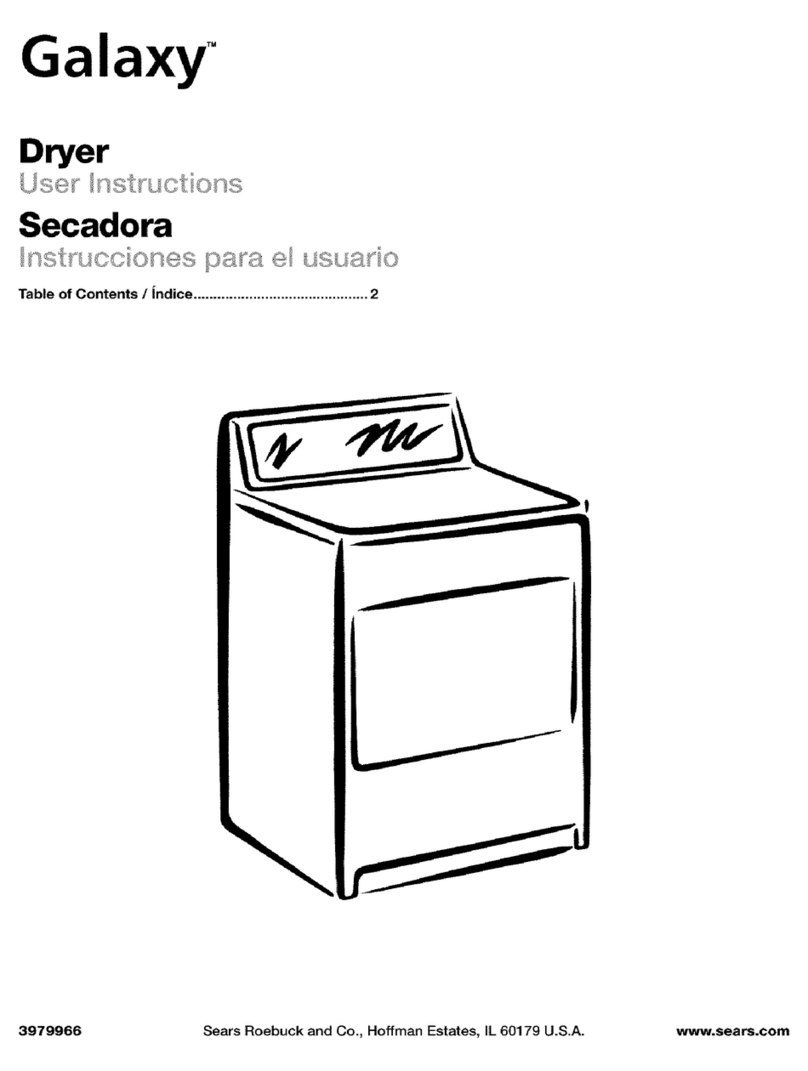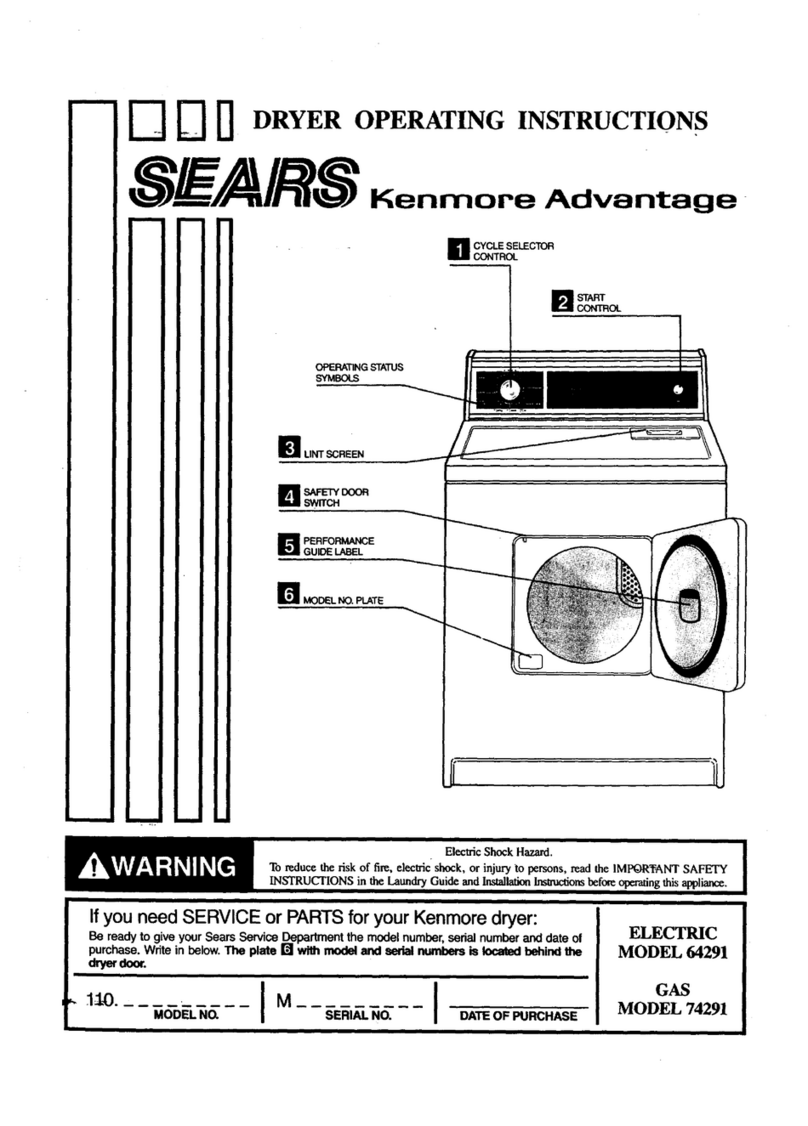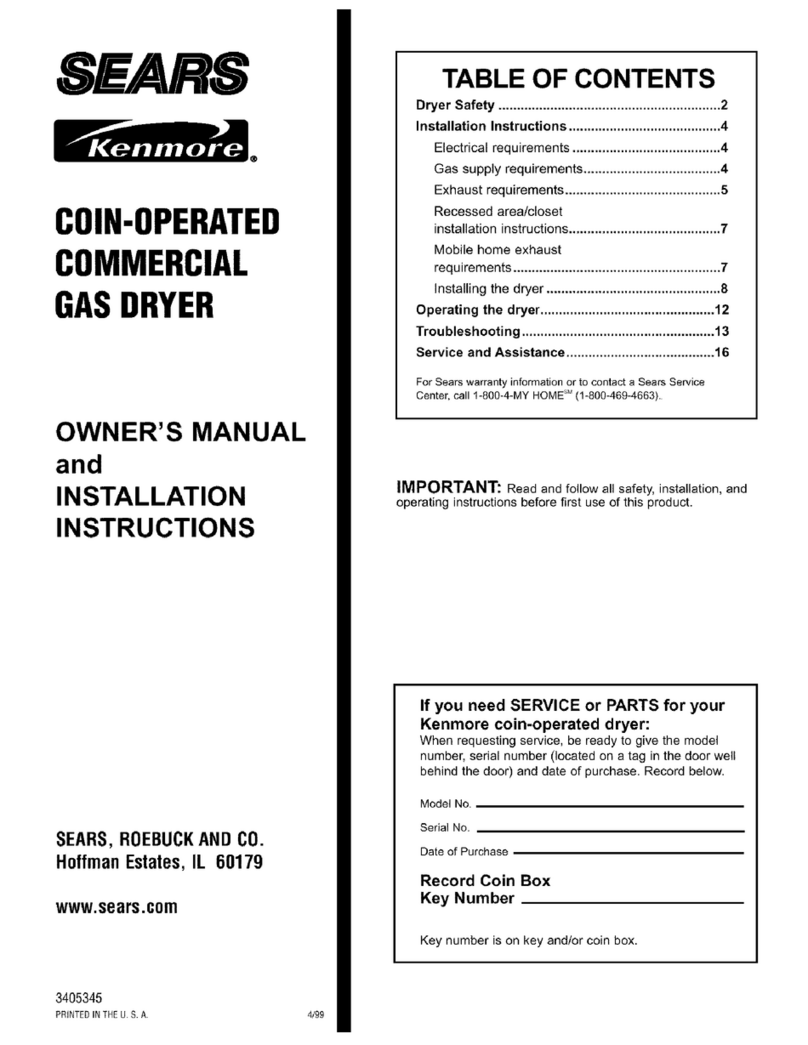
in
the
State
of
Massachusetts,
the
following
installation
instructions
apply:
@
Installations
and
repairs
must
be
performed
by
a
qualified
or
licensed
contractor,
plumber,
or
gasfitter
qualified
or
licensed
by
the
State
of
Massachusetts.
@
If
using
a
ball
valve,
it
shall
be
a
T-handle
type.
@
A
flexible
gas
connector,
when
used,
must
not
exceed
3
feet.
State
of
California
Proposition
65
Warnings:
WARNING:
This
product
contains
a
chemical
known
to
the
State
of
California
to
cause
cancer.
WARNING:
This
product
contains
a
chemical
known
to
the
State
of
California
to
cause
birth
defects
or
other
reproductive
harm.
IMPORTANT
SAFETY
INSTRUCTIONS
When
discarding
or
storing
your
old
clothes
dryer,
remove
the
door.
SAVE
THESE
INSTRUCTIONS
Table
of
Contents
DRYER
SAFETY
..ccccccccccssecssetssteecesesessssssssesseseseseseseessesesenenenenanaae
2
Venting
Requirements
cee
ueeeeescceeceuceecceuceuccuccscecucesceuccesceuceuece
9
INSTALLATION
REQUIREMENTS.
.....ssesesesssesssesesnensessseenanansanes
5
Plan
Vent
SYSteMwieccscccscscscsessscscscscsssesesescsesesesessscsesesesaees
10
TOONS
ANd
Parts
cesses
sseseeeeneneuesesseesenarasseueueesaeen
5
Venting
Kits
..ccccccscscesscsssssesssesessssscsessesssusnsesesessseesesascs
11
Location
Requirements
.........cscccceceeeecseseeceesenneeneenneecaees
6
Install
Vent
SyStenm
ccc
sccssessscsssecsscssscsvesessscsvesevescuees
12
ELECTRIC
DRYER
POWER
HOOKUP-CANADA
ONLY
...........
7
INSTALL
LEVELING
LEGS
wou
cccccsssssssscscscsesssesveresseesesnens
12
Electrical
Requirements
.....cccccccccecccceseeeeeeeeeeeececeeecereranaceeees
7
~~
MAKE
GAS
CONNECTIUON
cocococcccccccccccccccccccccceececocececececececececeee
42
GAS
DRYER
POWER
HOOKUP.
........cssssssesecessssssssceeeesessestateensnee
7
CONNECT
VENT
uieccccscscssssscssecessssssssssccesesessesesessscseressransaseeceevs
13
Electrical
Requirements
....cccsssssssssesestsssnsnseenstsnsasaanens
7
LEVEL
DRYER......ccccccsssssssscsscssssssssesscscessessscecsesseseesecseseesseeeaeses
13
Gas
Supply
Requirements
........ccccccccscscscscsccecceseeeeeeseneneneeene
8
COMPLETE
INSTALLATION
CHECKLIST
cececcccccococccccccccccccecece
44
VENTING
..
ccccccecececenenerereeeneecececeeneeeneececececececeeececesedetetececedeeeeaeeeaeaes
9
REVERSE
DOOR
SWING
(OPTIONAL)
.u....ccccccccscccsscccscsesssees
44
TROUBLESHOOTING.
.....ccscsesescscscsesesccenenenenssusasseseeeeeususueceueueees
17
Indice
SEGURIDAD
DE
LA
SECADORA........csssssessssssevsssevsssevsesaces
18
—
VENTILACION
.ucccccccccccscccccsesssscssscsseceecsssvesseeassnssseeacsneseesaeees
26
REQUISITOS
DE
INSTALACIOON
.......ccccccssssceceeeeesecaceeeeesenncaeens
20
Requisitos
de
ventilacion
......cccccccssscsscccccssssesseccseessneeceees
26
Herramientas
Y
PIOZAS
.....ccccccesensnensssssssenesesesesssssssssescneners
20
Planificacion
del
sistema
de
ventilacion
wesc
27
Requisitos
de
UDICACION
......sssssccessscecssecsesensesssueseeeees
21
Juegos
de
VENtHACION
wc
cccccs
cece
seeee
ee
cesseeseneeeseeesenaeeeeenene
28
CONEXION
DEL
SUMINISTRO
DE
LA
SECADORA
Instalacion
del
sistema
de
VentilaciOn
.........sccsssseeseaeee
29
ELECTRICA-SOLO
EN
CANADA
Quuececcscsscsssecsecessesessseessecsssseses
23
INSTALACION
DE
LAS
PATAS
NIVELADORAG........1scssesseees
29
Requisitos
Ch6ctric0s
.0......ccccsssscccccssscsecececessseaccceensencaeens
23
CONEXION
DEL
SUMINISTRO
DE
GAG...........sssssssessrseseeseees
30
CONEXION
DEL
SUMINISTRO
CONEXION
DEL
DUCTO
DE
ESCAPE
DE
LA
SECADORA
A
GAG...
ccccccscsccccccccceccccecececeesestececececccecees
23
NIVELACION
DE
LA
SECADORA.......csccsscsseccssecseesscersecscneaeess
Requisitos
Ch6ctric0s
........ccccssscccccecssescccceeecesecaceeeeeeeaacaeens
23
LISTA
DE
CONTROL
DE
LA
INSTALACION
TERMINADA....
32
Requisitos
del
SUMINIStFO
CE
GAS
...cccccccececeeeeeecececcerececeee
24
CAMBIO
DEL
SENTIDO
DE
ABERTURA
DE
LA
PUERTA
....
32
SOLUCION
DE
PROBLEMAG.|........:::s:ceseseeeseseeeseccecererenersestees
36
Table des
matiéres
SECURITE
DE
LA
SECHEUSE.......cccsssssssssssesssnsecssneessnsenssnsees
37)
EVACUATION
L..ccccccccssssssscssessssecsccuseeeseussessnseessuncessruneesenueereuuee
45
EXIGENCES
D’
INSTALLATION
Sede
ded
dade
edeededaeaaddedeedenasaneaadaadanaene
Exigences
concernant
PE@vacuatlon
cc
ccccccececcceccecccecceccceces
45
Outillage
et
PIECES
«0...
scsesseerserecceess
Planification
du
systéme
d’évacuation
........cccsseceseesecees
46
Exigences
d’emplacement
“
Trousses
C’6VACUATION
......cccccceccecccseccececcececcececcsceacseearseeaee
47
RACCORDEMENT
A
VALIMENTATION
ELECTRIQUE
Installation
du
circuit
d’évacuation
wc
48
DE
LA
SECHEUSE
ELECTRIQUE
-
CANADA
SEULEMENT..42
INSTALLATION
DES
PIEDS
DE
NIVELLMENT.......ccccsese0
48
Spécifications
Glectriques
..........secesssceeeeeneeeseeseceesees
42
RACCORDEMENT
AU
GAZ...
cecssscssssssesssesesessssessssnevevessseeenvees
49
RACCORDEMENT
A
L'ALIMENTATION
RACCORDEMENT
DU
CONDUIT
D'EVACUATION
....0.......000
50
D’UNE
SECHEUSE
A
GAZ.
cccccssccscsnccncencesnensecsceacencesteeseeseenceecess
42
REGLAGE
DE
L'APLOMB
DELA
SECHEUSE
..w...eescsesceeeeeees
50
SpEcifications
GlOCHHIQUES
.....cccccecececeesnesscecneeeeceeececeracacaceeeeeeees
42
ACHEVER
L'INSTALLATION
-
LISTE
DE
VERIFICATION.......
51
Spécifications
de
Palimentation
ON
GaZ
...ccccccecccceeeeeeeeeeee
43
INVERSION
DU
SENS
DE
L'OUVERTURE
DE
LA
PORTE
(FACULITAP)
.........sssssssesssssssssssssssssensssessnenensees
50
DEPANNAGE
......ccccsssssesesensseesaceenuccsssecaseneeanensueeussacaseuesanengueausees
55

































